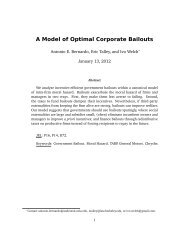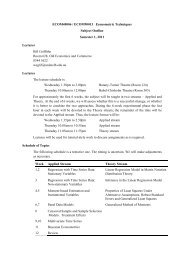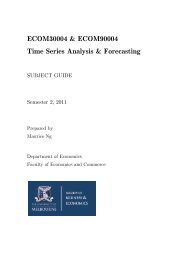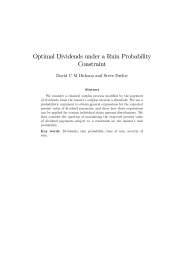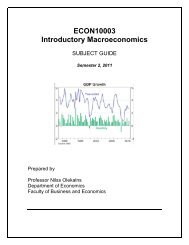Bayesian Inference in the Seemingly Unrelated Regressions Model
Bayesian Inference in the Seemingly Unrelated Regressions Model
Bayesian Inference in the Seemingly Unrelated Regressions Model
You also want an ePaper? Increase the reach of your titles
YUMPU automatically turns print PDFs into web optimized ePapers that Google loves.
2<br />
The objective of this chapter is to provide a practical guide to computer-aided<br />
<strong>Bayesian</strong> <strong>in</strong>ference for a variety of problems that arise <strong>in</strong> applications of <strong>the</strong> SUR<br />
model. We describe examples of problems, models and algorithms that have been<br />
placed with<strong>in</strong> a general framework <strong>in</strong> <strong>the</strong> chapter by Geweke et al (this volume); our<br />
chapter can be viewed as complimentary to that chapter. The model is described <strong>in</strong><br />
Section II; <strong>the</strong> jo<strong>in</strong>t, conditional and marg<strong>in</strong>al posterior density functions that result<br />
from a non<strong>in</strong>formative prior are derived. In Section III we describe how to use<br />
sample draws of parameters from <strong>the</strong>ir posterior densities to estimate posterior<br />
quantities of <strong>in</strong>terest; two Gibbs sampl<strong>in</strong>g algorithms and a Metropolis-Hast<strong>in</strong>gs<br />
algorithm are given. Modifications necessary for nonl<strong>in</strong>ear equations, equality<br />
restrictions and <strong>in</strong>equality restrictions are presented <strong>in</strong> Sections IV, V and VI,<br />
respectively. Three applications are described <strong>in</strong> Section VII. Section VIII conta<strong>in</strong>s<br />
methodology for forecast<strong>in</strong>g. Some extensions are briefly mentioned <strong>in</strong> Section IX<br />
and a few conclud<strong>in</strong>g remarks are given <strong>in</strong> Section X.<br />
II.<br />
MODEL SPECIFICATION AND POSTERIORS FROM A<br />
NONINFORMATIVE PRIOR<br />
Consider M equations written as<br />
y = X β + e i = 1,2,..., M<br />
(1)<br />
i i i i<br />
where<br />
y i is a T-dimensional vector of observations on a dependent variable,<br />
X i is a<br />
( T × K i ) matrix of observations on K i nonstochastic explanatory variables, possibly<br />
<strong>in</strong>clud<strong>in</strong>g a constant term, β i is a<br />
Ki<br />
-dimensional vector of unknown coefficients that<br />
we wish to estimate, and e i is a T-dimensional unobserved random vector. The M<br />
equations can be comb<strong>in</strong>ed <strong>in</strong>to one big model written as



